- Home
- Diana Wynne Jones
Reflections: On the Magic of Writing Page 7
Reflections: On the Magic of Writing Read online
Page 7
The situation I tried stepping into in Wilkins’ Tooth is a normal one—children out on their own, as they are in the playground or in the holidays. Their only safeguard is a constant cry of “It isn’t fair!” Their world is within but beyond that of adults, remote and lonely and echoing as the magic void where they find themselves after breaking Biddy’s spell. From it, you appeal to adults in vain. “Help!” says Jess on one occasion. “I beg your pardon?” says the adult. These adults who impinge do so because they are too eccentric to be part of their own world.
Now, push the reader directly against this situation and it is appalling. And it is all too familiar to most children. Yet I am wanting to remove their major prop by suggesting that this cry of “It isn’t fair!” is just not adequate. So I tried to make the situation acceptable in the way children make it acceptable to themselves—by finding it funny. Children are always laughing, jeering, and joking. For them, laughter is not a way of dismissing things. They learn by it. Laughter staves off the fear, horror, or bewilderment they might feel so that they can come to grips with the facts. Treat the facts that way in Wilkins’ Tooth and you can make a fantasia on the notion of justice—“It isn’t fair!” leads to a tooth for a tooth, which in turn leads to the secretive nastiness of witchcraft—and might even suggest the halting operation of mercy.
Further possibilities open up. If you treat a thing as funny the way children do, you have a ready-made bridge to fantasy. Kids tell dreadful punning jokes, every one a pocket fantasy: Q. What lies on the seabed and shivers? A. A nervous wreck. Poor thing. And if I am combining my own humorous thoughts with the action, why should I not, through this kind of fantasy, use the thoughts of the characters in the book in the same way?
I really enjoyed doing just this in The Ogre Downstairs. Thoughts figure as magic, and magic is a metaphor for thoughts. The basic idea is a kind of pun: what possible alchemy can make a set of people only yoked together by a remarriage start liking one another? Take alchemy to be magic chemistry, and there it is. The magic does all the usual things, like making people able to fly, or small, or invisible, because these things have the sort of dream-symbol quality I needed. The book is meant to function like a dream. You participate in a violent action full of hate and fury, but you are naturally horrified when Johnny pours blood about and tries to land the Ogre one with the vacuum cleaner. Books, like dreams, let you have your experience and reject it too. If I cast a fantastical-comical light over the action, you can accept it that more readily. But I was handling a situation basically more appalling than the one in Wilkins’ Tooth, one that needs serious things said, and the magic metaphors proved wonderfully useful here. Metaphors can be distant from their referent, as the toffee bars and the dust balls are distant from the children’s thoughts, but they can also be so close as to surface into the real thing. I surfaced twice, when what I was saying seemed too important to be left to chance: once when Caspar literally puts himself in Malcolm’s place; and again in the “cloak of darkness” section1 to make it clear that invisibility stands for thought. Johnny becomes all thoughts—violent ones. Thought is something no one can see, but it initiates most action.
The beauty of writing for children is that they admit to violent thoughts and accept that one violent emotion leads readily to another. Anyone knows this who has looked at a group of hilarious children and predicted, “There’ll be tears in a minute.” Hilarity is on the way to tragedy, and tragedy is close and frequent among children. Now tragedy entails awe. Children’s books deal much and splendidly in the awesome, and children love it. Possibly what they love is the nubbin of tragedy, modified by fantasy and its sting removed by laughter. For adults, this usually leads to sentimentality, but children are largely impervious to sentimentality. They acknowledge emotion simply.
In Eight Days of Luke I was experimenting in pushing the reader close to a tragic experience by laughing at it. David is in a situation I think most appalling of all—living with relatives who are not interested in him, but who justify their neglect by demanding his gratitude. I have made them funny, but the situation itself is not funny. David has to work out his loveless salvation for himself. His reaction summons up Luke. Luke is Loki,2 a magic metaphor used this time not solely to represent David’s thoughts but as a vehicle for awe. On a mundane level, he is amoral violence. If you accept him for what he is, as David does, you are willy-nilly hunted out by more awesome things. You are open to learn. The dreadful relatives mistake Luke’s nature and are not open to learn anything but anger. They get Mr. Chew.3 David moves among the entire pantheon, to Valhalla, and thence to discover real sympathy.
Because you cannot rely on children having read anything, my notion was to let the Norse legends I used make their own impact. I dissolved the action into a series of images in the latter part of the book to set the reader face to face with the awesome. At the World-tree David cheats his fate by learning from it. Stupid little girls help. At Wallsey, Cousin Ronald sees a bunch of yobbos and one-armed bandits. His is the comic view diminished. You no longer need that much, since David is dimly aware of the hall of the great dead opening onto a mundane fairground. I wanted to show how the awesome leads both to and from everyday life. The gods themselves are the big thoughts that stalk through ordinary actions, as much a part of experience as the days of the week—which of course these gods literally are.
After this I could go on to remove the action from ordinary life and see what happens then. As I said, the possibilities are boundless.
Fantasy Books for Children
A short piece on the lasting impact of fantasy, this article was commissioned by The Good Book Guide for an introduction to the Fiction and Fantasy section of The Good Book Guide’s annual selection of children’s books in 1991–2.
The Good Book Guide is a subscription-only journal for everybody who wants to know about and buy books published in the UK. It was founded in 1977 to offer an informed, independent selection of outstanding books.
Writers of fantasy for children have a heavy responsibility: anything they write is likely to have a profound effect for the next fifty years. You can see why if you ask ten adults which book they remember best from their childhood. Nine of them will certainly name a fantasy.
If you inquire further, you will find your nine adults admitting that they acquired many of the rules they live by from this book that so impressed them. This may not necessarily mean rules of morality—though it may—but wider things like what ways of behaving are wise, or unwise; or how to spot a person who is going to let you down; or what frame of mind in which to face a disaster; or possibly the way you look at life in general. For instance, when I discovered Brunhilde1 from an antiquated retelling of Norse legends and found that she was a warrior, I was intensely excited: now it didn’t matter anymore that I was born a girl.
This excitement is something all nine adults are likely to confess to, whatever else the book gave them. The book endowed them with experience which they could not get any other way, by speaking to them in a way and at a level that touches the roots of the imagination. They will also probably say the book made them laugh or cry, or both. Good. The emotions are very important. You need to acknowledge their power at the earliest possible age. It is the only way to get the rest of life straight.
As you see, it is a heavy responsibility. I think all writers of fantasy know this, but do not dwell on it. Their aim is to give children an experience.
The Value of Learning Anglo-Saxon
On August 30, 1991, The Times Literary Supplement published a commentary debate on the future of Old English. The critic Valentine Cunningham, who is a professor of English Language and Literature at the University of Oxford, called for an end to the compulsory teaching of Anglo-Saxon in the Oxford English course. Opposing him was medievalist J. A. Burrow, Diana Wynne Jones’s husband.
That same day Diana wrote this letter to the editor of The Times Literary Supplement. Although there was correspondence on the topic for the following three issues
(mostly supportive of teaching Anglo-Saxon), Diana’s letter was not published.
Dear Sir,
As a writer, I resent Val Cunningham’s implication that learning Anglo-Saxon is a dead loss to all writers. I would like to put a writer’s case for being forced to learn Anglo-Saxon as part of a degree in English.
Forced is the word. I would not have chosen to learn it; I did not take to it; and I frequently fell asleep with my face on the library blotter trying to learn paradigms. In addition, when I was an undergraduate at Oxford, Anglo-Saxon texts were not taught as literature but as exercises in translation and as mines for fearsome problems called “cruxes.” So it says volumes for these texts that the actual things written in Anglo-Saxon came blazing through all tutors’ attempts to quench them.
Take Beowulf—a large poem that is thrown at you. Laboriously you realize that its writer has signaled that he is giving you an epic, a promise he proceeds to fulfill in fluid and clangorous language through linked episodes, some of them closely attentive to the hero, some ranging outward into history. Even before it had dawned on me that I was studying a masterpiece nobody had told me about, I found I was learning from it as a writer. I can safely say that this anonymous poem taught me more about how to orchestrate and shape a narrative than any writer of more recent date. By this I mean the “novelistic” or engineering part of writing: when to devote detailed attention, when to slide over, how to thunder and how to restrain, and where to do it; and of course how to dovetail a narrative into the rest of history and make it relevant. It was a privilege to watch someone from so long ago doing all this so consummately well.
I do not think you gain the same sense of privilege from reading a translation. You certainly miss out disastrously on the shorter poems, like the cloudy and emblematic “Dream of the Rood,” where part of the point is that terms from older battle epics are transferred to Christian use; or the hints and allusions in “Widsith” or “The Wife’s Lament.” I forget which of the “Wanderer” or the “Seafarer” was a “set” text for us to study. I read them all avidly, realizing that here was the origin of the queer, sideways narrative manner of the Border Ballads—and again learned.
Oddly enough, the main thing I learned was that Anglo-Saxon (like the Ballads) is still very much with us today: it is English in all sorts of ways. Take “The Battle of Maldon,” where the leader, Byrhtnoth, is the first recorded example of winning the toss and putting the opposition in to bat on a perfect pitch; or, on a more serious note, take the prose of Ælfric and Wulfstan. A lot of the words are different, but the basic sentence and the basic paragraph, the sinews and engineering of it, are precisely as in modern English. And because the Anglo-Saxon vocabulary was not large, you can watch these prose writers doing much with little. They use every device possible of the rhetoric that Val Cunningham appears to believe was invented by the Renaissance or somewhen—and these of course are the stock in trade of any writer. Reading Ælfric and Wulfstan slowly in the original, I gained more knowledge of—for instance—how to build a paragraph, than I ever did from the mannered stuff in Tristram Shandy.
This is all personal, but I would like to add that I am by no means the only imaginative writer to be inspired by being made to learn Anglo-Saxon. There was a whole generation of us, and others after that. It seems hard on future writers, if they are not to be put to this enabling experience somewhere.
Yours sincerely,
Diana Wynne Jones
The Halloween Worms
This comic article shows how Diana Wynne Jones could find humor even in the roughest circumstance, and how incidents from her books were always returning to haunt her.
This is a true story, even though it came out of a book. You see, what I write in my books and think I have made up has a creepy way of coming true. I noticed it first over The Ogre Downstairs. When I wrote that book, we were living in a new house with a flat roof and almost no stairs. The roof turned out to dissolve in rain, the lavatories every so often flushed boiling water, and we had an electric fountain in the living room, because the builders had got confused about which were electric cables and which were heating pipes. I was so sick of that house that I invented a quite different one for The Ogre Downstairs—a tall, thin house with lots and lots of stairs.
Now I live in a tall, thin house with lots and lots of stairs. I didn’t do it on purpose. It came about by accident, in an awful hurry. But the house is almost exactly like the house I put in that book.
After that, things out of other books started coming true too. It was quite frightening. Imagine meeting the most sinister baddie you have ever invented (or thought you had invented), and hearing him say exactly the things you had put in the book for him to say. That happened. I asked other writers whether anything like this had ever happened to them. “Oh, yes,” they said. “Isn’t it creepy?” It was. I decided that in the next book I wrote I would put in so many things from real life that it couldn’t come true because it had happened anyway. Ha, ha. I decided to write about my schooldays.
The book was called Witch Week. It takes place in a very old-fashioned school at Halloween. The thing about writing a book is that, whatever you mean to do, you find the book takes on a life of its own from the first page onward. The school in this book turned into a sort of redbrick Disneyland castle as soon as I started to write, and the headmistress was almost a monster. But one bit I firmly put in from my schooldays, and that was the custom that certain pupils had to sit beside the Headmistress at High Table every lunchtime and make polite conversation. The rule was that you had to wait until the headmistress started to eat and then use the same eating implement as she did. And she always used a fork. For everything. People were forced to eat runny rice pudding with forks. It was like a medieval torture. I was very bad at eating with a fork, and I was also very bad at polite conversation, because the mere sight of the awful food we used to have seemed to inspire me to describe it, out loud. “Fishes’ eyes in glue,” I used to find myself saying. “Dead daffodils and mashed caterpillar.”
I put all this, exactly, in the book. The girl in it finds she can’t stop describing the food as she sits beside the headmistress. But, in the way books do, something took over and made that dinner a bit different from the ones I used to have. There are grand visitors, so the High Table gets given a starter. The girl looks at it, and it seems to be worms in custard. Really, of course, it is seafood cocktail. And the rest of the book got less and less like my schooldays. They were all tearing about in the nights just before Halloween, some of them riding broomsticks, and the rest of them causing the most peculiar bumps in the night, and there were all sorts of goings-on in the washrooms.
The book had not long been published when I got an invitation to attend a reunion—not a school reunion, that would have warned me off; but a reunion of people who used to come to the conference center my parents ran when I was a child. It was to be the weekend of Halloween, because that was half term and everyone was free. So we said we would go.
The place was out in the country and extraordinarily hard to find. We drove round and round, and we didn’t find the driveway until it was getting dark. It was a very long driveway. The first thing that warned us what we might be getting to was a set of dim, white goalposts looming out of the dusk. Then we drove round some dark trees and found huge, dark buildings ahead. There were battlements and towers. A castle? No. The last sunset came through one of the buildings and showed that it had pointed church windows, vast ones. A ruined abbey then? All the buildings were quite dark and absolutely quiet, but there was one dim orange light, low down, shining through a pointed window. We parked the car beside it and stuck our heads through a pointed door. There was nobody there, nothing but a vaulted stone corridor leading into darkness. But there was a smell. One sniff and we knew what that building was. It was a school. I don’t know what makes the smell of a school always so unmistakable, any more than I know what makes the smell itself—old socks and chalk? Tests and timetables?—but it
is always the same whether the building is new or old. But there was no one there. We didn’t like to barge in, in case we had come to the wrong place, so we walked round the outsides of the huge, churchlike buildings, trying to find someone to ask. Owls hooted. Bats fluttered against the last brown sunset, just like the start of the creepiest horror story you have ever read, and we never found a soul. So we went round again, back to the dim orange light.
There, suddenly, there were a few people, so suddenly that I began to feel they had been laid on by magic. They were all people that I hadn’t seen for at least twenty years, and that was very creepy. They all looked just the same, except they looked as if they had made themselves up to look old by powdering their hair and painting on wrinkles and sticking white beards on their faces. But they were all very friendly, and shortly we found ourselves being ushered into the grand reunion dinner. That took place in the great dining hall, which was like the biggest cathedral I had ever seen, all pointed arches stretching away into darkness. It turned out that very few people had been able to attend the dinner, so there were only ten or so of us at the High Table, which was so big that you had to shout to the person beside you. And winds blew out of the dark part of the Great Hall, bringing the school smell in gusts, like the scent of dead schoolboys. It was half term, we were told, so all the pupils had gone home.
But it was also Halloween, so, naturally, the first thing we were given to eat was a bowl of yellow stuff with little, pink, wriggly things floating in it. “Worms in custard!” I thought, peering at the stuff in the candlelight. “Seafood cocktail!” shouted the person on my left. “How delicious!”
I managed not to describe the worms out loud, but they were awfully hard to eat. That was followed by daffodil buds and shoe soles, with little yellow flowerpots someone told me were Yorkshire puddings. And all the while the winds blew, bringing the ghosts of schoolboys out of the dark hall. Just the place for things to go bump in the night, I thought, wishing we were not staying the night.

 Fire and Hemlock
Fire and Hemlock Reflections: On the Magic of Writing
Reflections: On the Magic of Writing The Game
The Game The Crown of Dalemark
The Crown of Dalemark Deep Secret
Deep Secret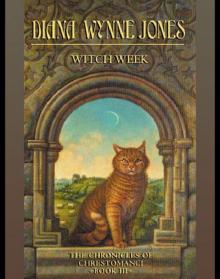 Witch Week
Witch Week Year of the Griffin
Year of the Griffin Wild Robert
Wild Robert Earwig and the Witch
Earwig and the Witch Witch's Business
Witch's Business Dogsbody
Dogsbody Caribbean Cruising
Caribbean Cruising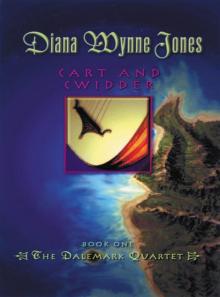 Cart and Cwidder
Cart and Cwidder Conrad's Fate
Conrad's Fate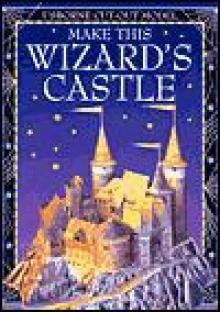 Howl's Moving Castle
Howl's Moving Castle The Spellcoats
The Spellcoats The Pinhoe Egg
The Pinhoe Egg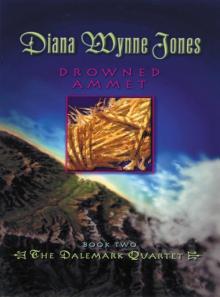 Drowned Ammet
Drowned Ammet The Ogre Downstairs
The Ogre Downstairs Dark Lord of Derkholm
Dark Lord of Derkholm Castle in the Air
Castle in the Air The Magicians of Caprona
The Magicians of Caprona A Tale of Time City
A Tale of Time City The Lives of Christopher Chant
The Lives of Christopher Chant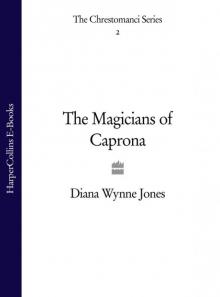 The Magicians of Caprona (UK)
The Magicians of Caprona (UK)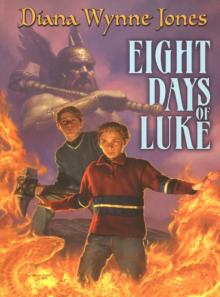 Eight Days of Luke
Eight Days of Luke Conrad's Fate (UK)
Conrad's Fate (UK)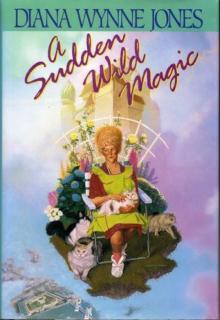 A Sudden Wild Magic
A Sudden Wild Magic Mixed Magics (UK)
Mixed Magics (UK) House of Many Ways
House of Many Ways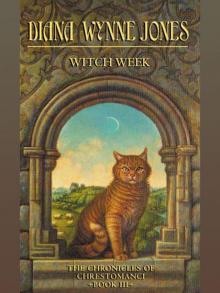 Witch Week (UK)
Witch Week (UK) The Homeward Bounders
The Homeward Bounders The Merlin Conspiracy
The Merlin Conspiracy The Pinhoe Egg (UK)
The Pinhoe Egg (UK) The Time of the Ghost
The Time of the Ghost Hexwood
Hexwood Enchanted Glass
Enchanted Glass The Crown of Dalemark (UK)
The Crown of Dalemark (UK)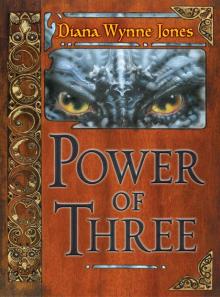 Power of Three
Power of Three Charmed Life (UK)
Charmed Life (UK) Black Maria
Black Maria The Islands of Chaldea
The Islands of Chaldea Cart and Cwidder (UK)
Cart and Cwidder (UK) Drowned Ammet (UK)
Drowned Ammet (UK) Charmed Life
Charmed Life The Spellcoats (UK)
The Spellcoats (UK) Believing Is Seeing
Believing Is Seeing Samantha's Diary
Samantha's Diary Aunt Maria
Aunt Maria Vile Visitors
Vile Visitors Stopping for a Spell
Stopping for a Spell Freaky Families
Freaky Families Unexpected Magic
Unexpected Magic Reflections
Reflections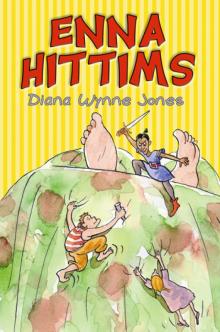 Enna Hittms
Enna Hittms Mixed Magics: Four Tales of Chrestomanci
Mixed Magics: Four Tales of Chrestomanci